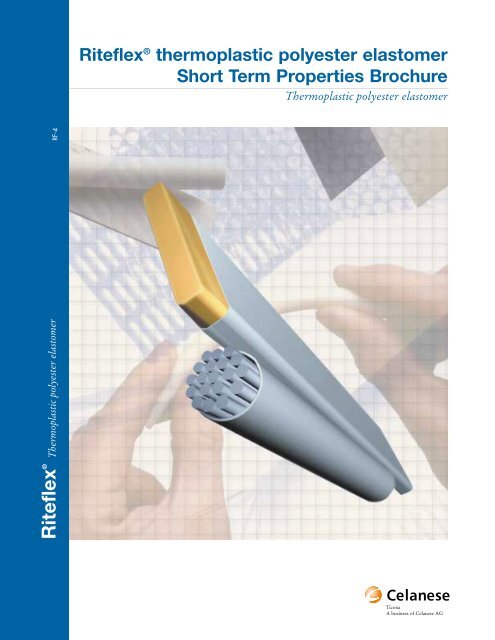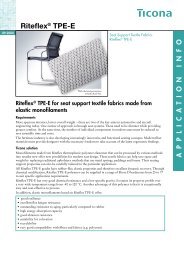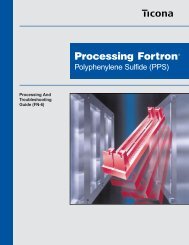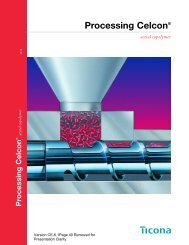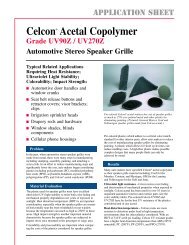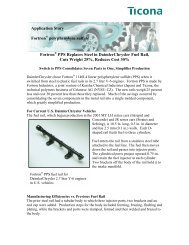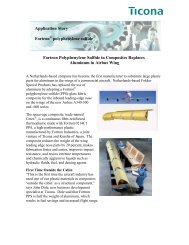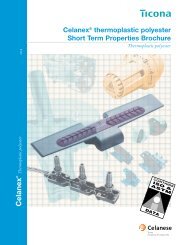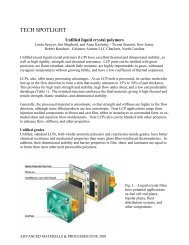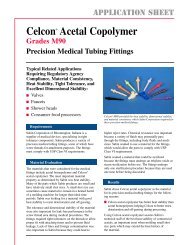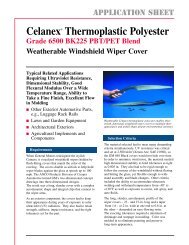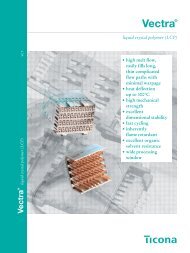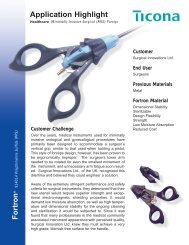Riteflex Polyester Short Term Properties - Hi Polymers
Riteflex Polyester Short Term Properties - Hi Polymers
Riteflex Polyester Short Term Properties - Hi Polymers
You also want an ePaper? Increase the reach of your titles
YUMPU automatically turns print PDFs into web optimized ePapers that Google loves.
<strong>Riteflex</strong> ® thermoplastic polyester elastomer<br />
<strong>Short</strong> <strong>Term</strong> <strong>Properties</strong> Brochure<br />
Thermoplastic polyester elastomer<br />
<strong>Riteflex</strong> ® Thermoplastic polyester elastomer<br />
RF-4<br />
Ticona<br />
A business of Celanese AG
<strong>Riteflex</strong> ® Thermoplastic polyester elastomer<br />
Introduction<br />
<strong>Riteflex</strong> ® thermoplastic polyester elastomers (TPE) are well-suited for applications which<br />
require toughness, and where thermosets and lower performance thermoplastic elastomers<br />
cannot perform. <strong>Riteflex</strong> ® TPE combines excellent fatigue resistance with outstanding chemical<br />
resistance, good low temperature impact and a wide temperature use range (-40˚F to 250˚F).<br />
Consult the appropriate Material Safety Data Sheet (MSDS) before attempting to process <strong>Riteflex</strong><br />
thermoplastic polyester elastomer.<br />
Application Areas<br />
■ Hose and tubing<br />
■ Seals and gaskets<br />
■ Belts<br />
■ Pump diaphragms<br />
■ Energy absorbing devices<br />
■ Coil (wire) coating<br />
■ Hooks and fasteners<br />
■ Film and sheet<br />
■ Electrical/Electronic<br />
connectors<br />
■ Nonwoven fabric<br />
■ Footwear hardware<br />
■ Polymer modification<br />
■ Monofilament<br />
Grade Characteristics<br />
635 Extrusion/Injection Grade, 35 Shore D Hardness.<br />
640 Extrusion/Injection Grade, 40 Shore D Hardness.<br />
647 Extrusion/Injection Grade, 47 Shore D Hardness.<br />
655 Extrusion/Injection Grade, 55 Shore D Hardness.<br />
663 Extrusion/Injection Grade, 63 Shore D Hardness.<br />
672 Extrusion/Injection Grade, 72 Shore D Hardness.<br />
677 Extrusion/Injection Grade, 77 Shore D Hardness.
<strong>Riteflex</strong> ® Thermoplastic <strong>Polyester</strong> Elastomer – Typical ASTM <strong>Properties</strong><br />
ASTM<br />
<strong>Properties</strong> Test Units 635 640 647 655 663 672 677<br />
Method<br />
Physical<br />
Specific Gravity D792 — 1.14 1.15 1.17 1.19 1.24 1.25 1.29<br />
Water Absorption, D570 % 0.6 0.5 0.5 0.4 0.3 0.2 0.2<br />
24 Hr. Immersion<br />
Mold Shrinkage, Flow Direction D955 in/in 0.009 0.010 0.013 0.015 0.019 0.020 0.020<br />
Mechanical<br />
Tensile Strength, @ 5% Yield D638 psi 380 561 875 1,291 1,844 2,760 3,260<br />
(Type I bar)<br />
@ 10% Yield D638 psi 607 912 1,341 1,884 2,596 3,628 4,130<br />
Tensile Strength,<br />
(Type IV bar),<br />
@ Break D638 psi 1,920 3,000 3,260 3,650 3,800 4,240 5,000<br />
Elongation @ Break D638 % 470 480 470 430 320 300 310<br />
Tensile Modulus D638 psi 8,400 13,400 21,900 34,900 52,900 42,100 100,000<br />
Flexural Modulus @ -40˚C D790 psi 12,300 22,400 53,800 98,200 226,800 343,700 —<br />
@ 23˚C D790 psi 8,800 12,300 21,300 30,500 47,200 74,200 100,000<br />
@ 100˚C D790 psi 4,650 7,500 11,900 16,100 23,500 32,200 —<br />
Izod Impact, Notched @ -40˚C D256 ft lb/in NB NB 5.1 2.7 0.5 0.7 0.7<br />
@ 23˚C D256 ft lb/in NB NB NB NB NB 4.1 4.1<br />
Tear Strength D1004 lb/in 575 630 720 840 1,100 1,240 2,065<br />
Tear Strength D624 lb/in 490 720 930 930 1,050 1,220 2,040<br />
Resilience, Bashore D2632 % 60 59 53 48 40 40 40<br />
Ross Flex D1052 cycles to failure >1MM >1MM >1MM >1MM >1MM >1MM >1MM<br />
Taber Abrasion † D1044 mg/1000 cycles 121 90 67 85 62 30 30<br />
Durometer Hardness D2240 (Shore D) 35 40 47 55 63 72 77<br />
Thermal<br />
Melt Index @ 220˚C D1238 gms/10 min. 10 –15 8 –12 8 –12 7–11 8 –12* 10–15** 10 –20**<br />
Melt Point D3418 ˚C 164 180 191 200 208 214 217<br />
Softening Point, Vicat D1525 ˚C 107 136 162 181 195 — 204<br />
Coefficient of Linear E831 x10 -5 cm/cm/˚C 22.5 22.1 20.5 19.8 18.0 17.3 17.3<br />
Thermal Expansion<br />
* Melt index run @ 230˚C<br />
** Melt index run @ 240˚C<br />
† H-18 Wheel, 1000 g weight
<strong>Riteflex</strong> ® Thermoplastic <strong>Polyester</strong> Elastomer – Typical ISO <strong>Properties</strong><br />
ISO<br />
<strong>Properties</strong> Units Test 635 640 647 655 663 672 677<br />
Method<br />
Mechanical<br />
Tensile Strength at Break MPa 19.8 22 28.2 34.2 42.2 44.5<br />
Tensile Modulus 3 MPa ISO 527 60 66 125 190 360 690<br />
Flex Modulus MPa ISO 178 65 85 125 205 360 470 750<br />
Flex Stress @3.5% Deflection MPa ISO 178 2.3 2.9 4.3 6.8 11 23<br />
Electrical<br />
Relative Permittivity at 1MHz DIN VDE 0303 4.7 4.7 4.6 4.4 4 3.3<br />
Dissipation Factor at 1MHz IEC250 0.03 0.03 0.04 0.04 0.04 0.02<br />
Dielectric Strength P25/P75 kV/mm IEC 243 Teil 1 13 13 13 14 14 16<br />
Comparative Tracking Index V DIN VDE 0303<br />
(CTI) Part 2, IEC 122 >600 >600 >600 >600 >600 >600<br />
Volume Resistivity ohm-cm IEC 93 5 x 10 12 5 x 10 12 5 x 10 12 4 x 10 12 2 x 10 13 4 x 10 14<br />
1) 50 mm/min<br />
2) 5 mm/mimn<br />
3) 1mm/min, secant at 0.05 to 0.25% elongation<br />
Eng.<br />
Conversion S.I.<br />
x<br />
=<br />
Units Factor Units<br />
ft-lb/in 53.40 J/m<br />
ft-lb/in 2 2.11 kJ/m 2<br />
Temperature conversion<br />
˚C to ˚F, use formula: ˚F = (1.8 x ˚C) + 32<br />
<strong>Riteflex</strong> ® 655 vs. 655HS, *Thermal Property Comparison<br />
Property<br />
ASTM<br />
Test Method<br />
655 655HS<br />
% Retention after 1 week,<br />
(oven aged @ 145˚C)<br />
Tensile Strength D638 82 98<br />
Tensile Elongation D638 10 95<br />
% Retention after 3 weeks,<br />
(oven aged @ 145˚C)<br />
Tensile Strength D638 19 88<br />
Tensile Elongation D638 1 31<br />
% Retention after 5 weeks,<br />
(oven aged @ 145˚C)<br />
Tensile Strength D638<br />
††<br />
80<br />
Tensile Elongation D638<br />
††<br />
31<br />
†† Specimen too brittle to test.<br />
* Unaged 655HS properties similar to 655, data sheets available upon request.
Typical Molding Conditions<br />
Machine<br />
Parameters 635 640 647 655, 663, 672, 677<br />
Barrel Temps.<br />
Rear 310 – 340˚F 325 – 360˚F 370 – 390˚F 390 – 420˚F<br />
Center 340 – 360˚F 360 – 390˚F 390 – 410˚F 420 – 450˚F<br />
Front 340 – 360˚F 360 – 400˚F 390 – 420˚F 420 – 460˚F<br />
Nozzle 340 – 370˚F 360 – 400˚F 390 – 420˚F 420 – 460˚F<br />
Melt Temp.* 340 – 370˚F 360 – 400˚F 390 – 420˚F 430 – 460˚F<br />
Mold Temp. 75 – 125˚F 75 – 125˚F 75 – 125˚F 75 – 125˚F<br />
Injection Pressure low – med low – med low – med low – med<br />
Injection Speed fast fast fast fast<br />
Screw Speed 60 – 125 rpm 60 – 125 rpm 60 – 125 rpm 60 – 125 rpm<br />
Back Pressure 0 – 50 psi 0 – 50 psi 0 – 50 psi 0 – 50 psi<br />
Cushion/Pad 0.2 – 0.4 in. 0.2 – 0.4 in. 0.2 – 0.4 in. 0.2 – 0.4 in.<br />
* Determine melt temperature using a hand held pyrometer under actual processing conditions.<br />
Injection Pressure: Keep the injection<br />
pressure low when starting the molding cycle;<br />
this will produce short shots. Gradually increase<br />
pressure by 50 – 100 psi until the cavity fills<br />
completely. When complete parts are ejected<br />
from the mold, raise the injection pressure<br />
approximately 100 psi, making sure the material<br />
does not flash.<br />
Drying: Material must be dried for 4 hours @<br />
225˚F. Pellet moisture content must be ≤ 0.05%.<br />
Regrind: Regrind should not exceed 25% when<br />
mixed with virgin material. Regrind must also<br />
be dried following the suggested conditions.<br />
Extrusion: Melt temperatures should be 10˚F<br />
above the low end of the typical melt range.<br />
Set the barrel temperatures to produce the<br />
suitable melt temperature.
NOTICE TO USERS: To the best of our knowledge, the information contained in this publication is accurate,<br />
however we do not assume any liability whatsoever for the accuracy and completeness of such information. Further,<br />
the analysis techniques included in this publication are often simplifications and, therefore, approximate in nature. More<br />
vigorous analysis techniques and/or prototype testing are strongly recommended to verify satisfactory part performance.<br />
Anyone intending to rely on such recommendation or to use any equipment, processing technique or material mentioned in<br />
this publication should satisfy themselves that they can meet all applicable safety and health standards.<br />
It is the sole responsibility of the users to investigate whether any existing patents are infringed by the use of the materials<br />
mentioned in this publication.<br />
Any determination of the suitability of a particular material for any use contemplated by the user is the sole<br />
responsibility of the user. The user must verify that the material, as subsequently processed, meets the requirements of the<br />
particular product or use. The user is encouraged to test prototypes or samples of the product under the harshest conditions<br />
likely to be encountered to determine the suitability of the materials.<br />
Material data and values included in this publication are either based on testing of laboratory test specimens and<br />
represent data that fall within the normal range of properties for natural material or were extracted from various published<br />
sources. All are believed to be representative. Colorants or other additives may cause significant variations in data values.<br />
These values are not intended for use in establishing maximum, minimum, or ranges of values for specification purposes.<br />
We strongly recommend that users seek and adhere to the manufacturer’s or supplier’s current instructions<br />
for handling each material they use. Please call 1-800-833-4882 for additional technical information. Call Customer Services<br />
at the number listed below for the appropriate Material Safety Data Sheets (MSDS) before attempting to process these<br />
products. Moreover, there is a need to reduce human exposure to many materials to the lowest practical limits in view of<br />
possible adverse effects. To the extent that any hazards may have been mentioned in this publication, we neither suggest nor<br />
guarantee that such hazards are the only ones that exist.<br />
<strong>Riteflex</strong> ® Thermoplastic <strong>Polyester</strong> Elastomers are not intended for use in medical or dental implants.<br />
Products offered by Ticona<br />
Celcon ® and Hostaform ® acetal copolymer (POM)<br />
GUR ® ultra-high molecular weight polyethylene (UHMW-PE)<br />
Celanex ® thermoplastic polyester<br />
Impet ® thermoplastic polyester<br />
Vandar ® thermoplastic polyester alloy<br />
<strong>Riteflex</strong> ® thermoplastic polyester elastomer<br />
Vectra ® liquid crystal polymer (LCP)<br />
Vectran liquid crystal polymer (LCP)<br />
Celstran ® long fiber reinforced thermoplastic (LFRT)<br />
Fortron ® polyphenylene sulfide (PPS)<br />
Celanese ® nylon 6/6 (PA 6/6)<br />
Topas ® cyclic olefin copolymer (COC)<br />
North America<br />
Ticona<br />
90 Morris Avenue<br />
Summit, NJ 07901<br />
Technical Information<br />
1-800-833-4882<br />
prodinfo@ticona.com<br />
Customer Service<br />
1-800-526-4960<br />
Visit our Internet Site at http://www.ticona.com<br />
for further information.<br />
Ticona<br />
A business of Celanese AG<br />
© 2001 Ticona Printed in USA 00-337/3M/0101<br />
<strong>Riteflex</strong> ® Thermoplastic polyester elastomer


